The Griffith’s Gnat is a versatile fly pattern for catching trout and grayling feeding on midges (emerging and egg-laying). This fly was developed by George Griffith, a famous American fly fisherman.
It’s a fantastic fly for a beginner to tie because of its simplicity and usefulness for fishing on rivers and stillwaters.
A great fly for your river and Stillwater fly boxes.
In the United Kingdom, black midge flies and other little insects of a similar size are frequently seen in rivers and stillwaters. Usually, hatches occur during the evening and in the morning during the height of summer.
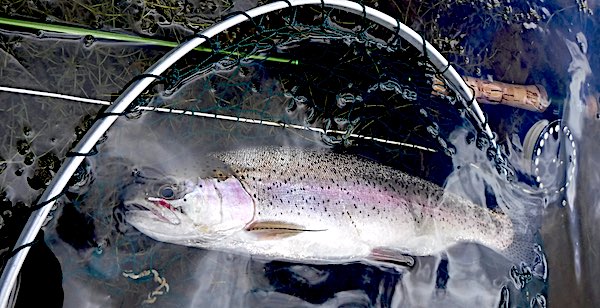
So, let’s take a look at what gnat and midge fly patterns I have in my fly box…
How to tie the Griffith’s Gnat dry fly
The fly is very simple to tie…
Essentially consisting of a peacock herl body and a grizzle cock hackle wound along the body (palmered). Therefore, a great dry fly for beginners to start their fly-tying journey.
Tying material list:
- Hook – Kamasan B402 (#16 & 18)
- Thread – Black 8/0
- Body – 2 strands of peacock herl
- Hackle – palmered genetic grizzle cock
Step-by-step tying instructions:

Step 1. Place the hook firmly in the vice and start the thread 1mm behind the eye. Wind the thread in touching turns down the hook shank and near the bend tie in a genetic cock hackle feather.
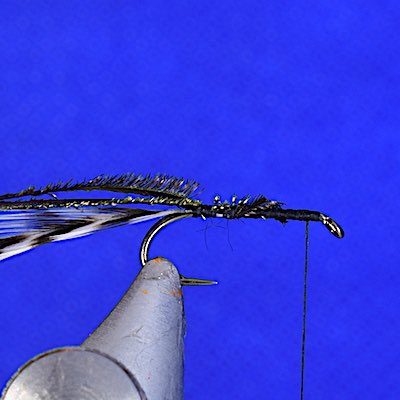
Step 2. Tie in 2 lengths of peacock herl and wind the thread up the hook stopping 2 mm before the eye.
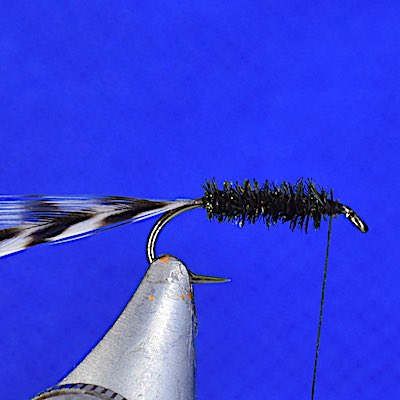
Step 3. Carefully wind the peacock herl in touching turns along the hook shank, tie off with the thread and trim the waste.
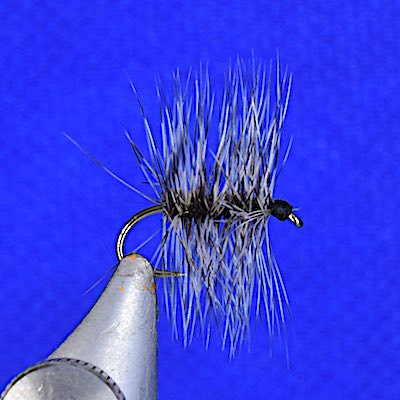
Step 4. Palmer the cock hackle over the peacock herl, tie off near the eye and trim away the waste. Form the head of the fly with the thread, whip finish, and varnish.
In addition to the standard pattern, I also tie a variant with added sparkle, which is a great midge fly pattern…
Griffith’s Sparkle Gnat:

Step 1. Place the hook firmly in the vice and start the thread 1mm behind the eye. Wind the thread in touching turns down the hook shank, catching in 2 strands of pearl crystal flash as tails.
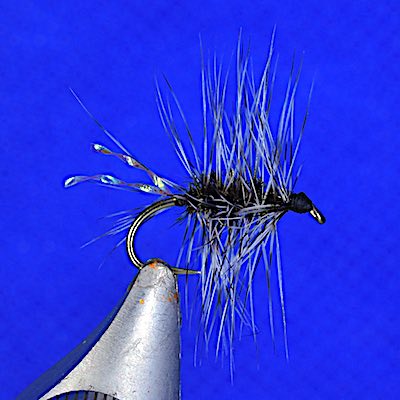
Next steps – Proceed to tie the fly as per steps 1 to 4 of the standard pattern above.
How to fish the Griffith’s Gnat
On UK rivers and stillwaters, this classic dry fly works well whenever fish are taking small flies on the surface, e.g. black midges, black gnats, small insects, etc.
During summer on the Welsh Dee, it’s often the only dry fly (size 18) that trout and grayling will take confidentially.
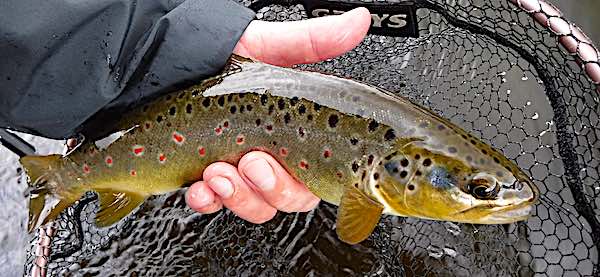
Equipment-wise, I use a 9ft 5# rod for dry fly fishing. Attached to the floating line is a 9ft 5X copolymer leader tipped with a 3 to 4 ft length of 3lb fluorocarbon. Fuller’s mud is applied to the fluorocarbon tippet to remove its shine and make it sink. Whereas, Mucilin grease is applied to the remainder of the leader.
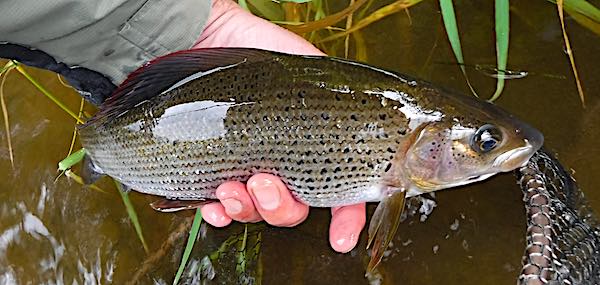
I use a double dry fly leader set-up when it’s difficult to see small dry flies in broken water.
The leader is constructed by tying a large sight-fly on the point of the leader and the gnat on a dropper 2 ft above the point fly.
On heavily fished waters, it is sometimes advantageous to trim the hackle on the bottom fly to make it sit lower in the water. Often this will improve hook-ups.
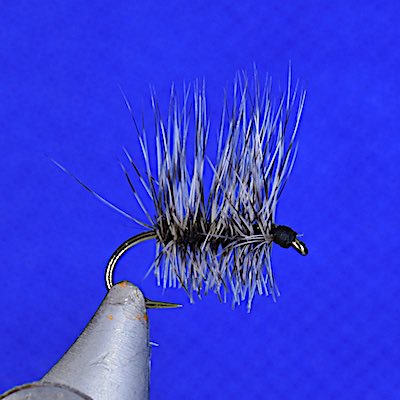
Finally, I hope this article stimulates you to tie the Griffith’s Gnat and test it on your local fishing location or take a trip to fish the Welsh Dee, where it catches fish when other flies fail.
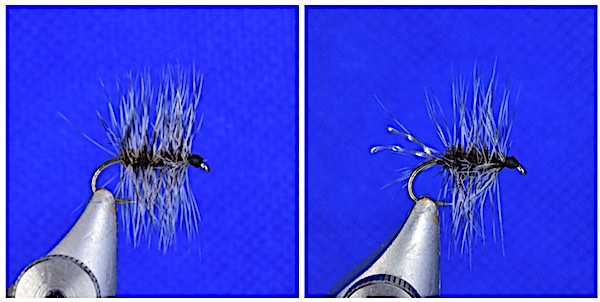
Brilliant piece Andrew , I’ve never heard of this fly before and a midge hatch used to be the kiss of death as nothing could match the match in terms of size and the best you could do was stick something shocking on and pull fast in the hope of breaking the fishes obsession with these tiny flies , but I see yours is an 18 , how small would you go , I suppose too small and your fly will not get notice
Love reading your stuff , keep it up !
Hi James,
I’ve never needed to go any smaller than a size 18 with the Griffith Gnat. If it’s an intense hatch of midges then try fishing it in tandem with a dry attractor fly, it might just help the trout focus on your midge offering.
I hope this helps, Andrew
HI Andrew
another very useful article
thanks very much for this
Cheers
A very good article as usual, this is one of my favourite patterns to fish on tune Dee and it can be very productive
Hi Steve,
Thanks for the feedback on the article.
Cheers, Andrew
Hi Andrew A lovely piece just letting you know that I’ve used one for many years on the River Dove at Doveridge and had similar success ad also on some medium small sized lakes,
Thanks for reminding me and other anglers that “we Can”.
Hi Sam,
Great to hear you have good success with these flies.
Cheers, Andrew
nice one Andrew like this fly works well for me
Excellent 🙂
Another good example of how “simple” flies will catch trout or other target fish. I have long argued that while complicated artistic flies are things of beauty, plain vanilla patterns are more often than not, the prime fish catchers.
When I first started tying flies at age eleven in 1956, I gravitated to the fancy, but writers like Ted Trueblood (sp?) soon set me on the life-long path of a preference for the simple ties.
Oh, well, it is all good if one can attract a fish or three.
Another valuable post, Sir!
Paul from Texas
Hi Paul,
It’s great to hear your insights on simple flies and I agree simple designs often outfish more complicated patterns.
Thanks for your feedback. Cheers, Andrew
Great wee fly, good article.
Great to hear you enjoyed it.
All great pieces worth reading every time
Hi Fred,
Thank for the feedback, glad you enjoyed the post.
Cheers, Andrew
Great post Andrew, interesting to hear how you set up too.
Thanks
Good article as usual Andrew
Great to hear you enjoyed it. Cheers, Andrew
So simple and so effective, thanks.
Yes – it’s a must for your dry fly box.
great vids andrew very informative keep them coming cheers kev
Thanks
A fly I use often, usually when all else fails and usually with success. There have been times recently when the grayling won’t look at the Griffiths gnat. I recently tried them with an orange otter tied on a Tiemco 17 barbless hook. Instant success that went on all evening. Is the Orange Otter a fly you use on the Welsh Dee?
Hi Les,
I’ve not tried an Orange Otter fly but will give it a go on the Welsh Dee.
Thanks, for the tip. Cheers, Andrew
Hi Andrew
Thanks for this, the Griffith’s Gnat had been a go to pattern of mine on the Dee got quite a while now. It often brings up when all else fails
A great article as ever
Hi Dave,
It’s great to hear you enjoyed it and thanks for the comments.
Tight lines, Andrew
Hi Andrew, as always a great article and it is such a simple fly but can be very effective. I am fishing a PSUK International on the River Tummel in Scotland in the summer and will certainly have a few gnats in the box. Thank you for sharing your knowledge. Tight Lines, Iain Fraser.
Hi Iain,
Great to hear you found it interesting and good luck for your trip to the Tummel.
Tight lines, Andrew